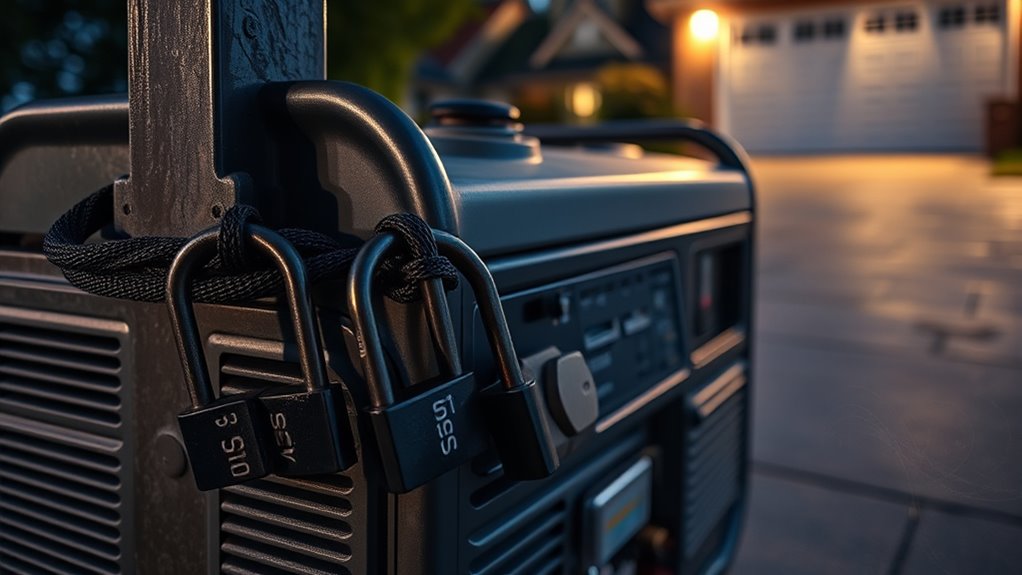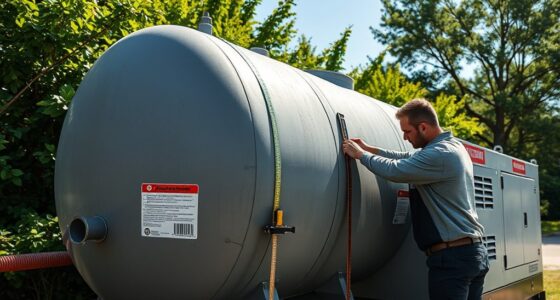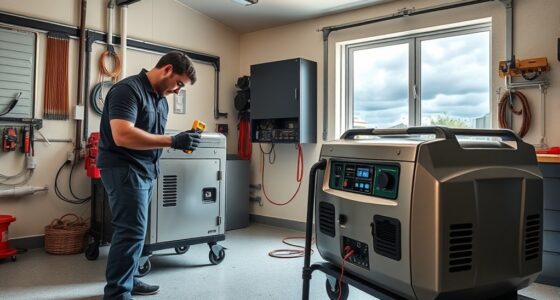To secure your generator against theft, you should install sturdy fencing, locks, and physical barriers to prevent access. Use GPS trackers and surveillance cameras for real-time monitoring, and add motion-activated lighting to deter intruders. Keep fuel stored safely, and develop clear theft response plans that include notifying law enforcement quickly. Regularly inspect your security measures, and stay connected with authorities. Following these steps can make your generator a less tempting target—discover more ways to protect your asset.
Key Takeaways
- Install strong physical barriers and secure fencing around the generator to prevent unauthorized access.
- Use high-definition security cameras with motion detection and proper lighting for surveillance.
- Store fuel in approved, locked containers away from the generator in a secure, well-ventilated area.
- Implement GPS tracking devices and remote monitoring to locate and protect your generator in real time.
- Develop and regularly practice a theft response plan, including quick law enforcement notification and recovery procedures.
Establish Physical Barriers and Enclosures
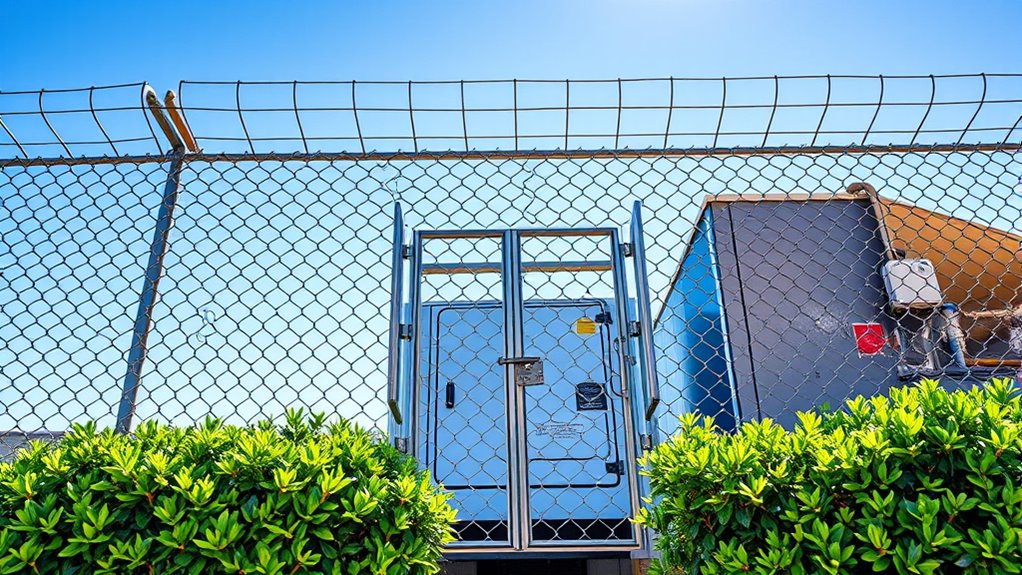
Establishing physical barriers and enclosures is essential to protect your generator from theft and vandalism. Start by installing strong fencing wire or metal mesh around your generator to create a sturdy barrier. Make sure the fence height and design prevent easy climbing and passing tools through. Use locked gates secured with heavy-duty padlocks to restrict access. Reinforce fence posts and anchoring points to stop removal or displacement. Regularly inspect the fencing for damage or weak spots to keep security tight. Adding lighting, such as bright, motion-activated floodlights, further deters intruders. Position these lights to eliminate shadows and ensure visibility. Incorporating security measures like surveillance cameras can provide additional evidence in case of attempted theft. Conducting a security assessment of your property can help identify vulnerabilities and improve your overall security strategy. According to security best practices, combining physical barriers with strategic lighting creates a formidable defense, making it difficult for thieves to target your generator unnoticed. Physical security measures can significantly reduce the risk of theft and provide peace of mind.
Implement Advanced Tracking and Monitoring Technologies
Building on physical security measures, implementing advanced tracking and monitoring technologies substantially enhances your generator’s protection. GPS tracking devices provide real-time location data, allowing you to monitor your generator’s position continuously. Choose compact, tamper-resistant trackers that blend into the generator housing and ensure the antenna has a clear sky view for reliable signals. These devices can be battery-powered or connected to the generator’s power supply for extended operation. Set up geofences to create virtual boundaries; you’ll receive instant alerts if your generator leaves designated zones. Remote monitoring platforms enable centralized oversight of multiple units, optimizing deployment and maintenance. When theft occurs, GPS data helps authorities locate and recover your equipment swiftly, reducing downtime and replacement costs. Generator theft is a common concern, so utilizing these advanced technologies provides an effective layer of security. Incorporating advanced security features can further deter theft attempts and provide peace of mind. Additionally, integrating privacy and security protocols ensures that your monitoring system remains protected from unauthorized access. Employing encryption methods adds an extra layer of protection to sensitive data transmitted during monitoring, safeguarding your assets from cyber threats.
Enhance Security With Alarm Systems and Proper Lighting
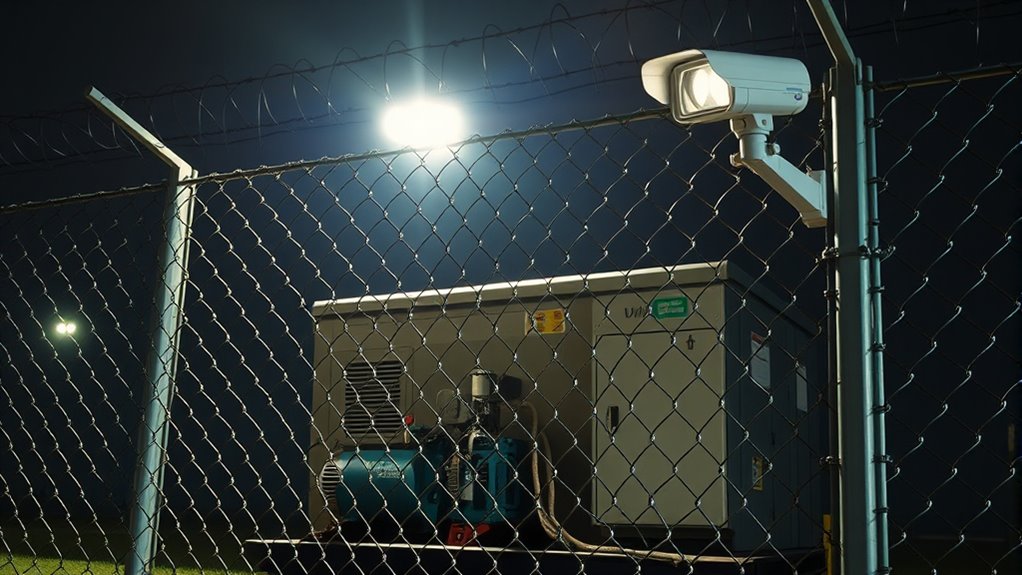
Installing motion-activated lighting around your generator can scare off intruders by sudden illumination, making theft attempts riskier. Visible alarm indicators, like flashing lights or warning signs, warn potential thieves that your system is active. Combining these measures creates a strong visual deterrent that enhances your overall security. Additionally, security camera systems can also help monitor the area and record any suspicious activity, providing valuable evidence if theft occurs. Proper lighting placement is essential to ensure complete coverage and maximize deterrence. Proper lighting and alarm systems can also be integrated with security protocols to create a comprehensive security setup for your generator. Incorporating well-designed security measures further discourages theft and enhances peace of mind.
Motion-Activated Lighting Deterrence
Motion-activated lighting is an effective way to enhance your generator’s security by startling intruders and increasing their risk of detection. When someone approaches, sudden illumination makes it harder for thieves to move unnoticed, especially if placed near access points. Efficient LED lights minimize energy use, lowering bills and environmental impact. Smart controls allow you to set timers, remote adjustments, and sync with alarms or cameras, creating a layered defense. Proper placement at vulnerable spots and wide-angle sensors ensure thorough coverage without false triggers. However, be mindful of environmental factors like animals or passing vehicles that could cause false activations. Combining lighting with alarm systems amplifies deterrence, making unauthorized access riskier and more detectable.
| Placement Tips | Benefits |
|---|---|
| Install at entry points | Maximize visibility and deterrence |
| Use wide-angle sensors | Cover larger areas efficiently |
| Avoid obstructions | Ensure reliable detection |
| Mount at 6-10 feet | Balance sensitivity and coverage |
| Use multiple lights | Prevent blind spots |
Visible Alarm Indicators
Visible alarm indicators play a crucial role in deterring theft by signaling that your generator is under active security surveillance. Flashing LED lights, strobe signals, or other visible components alert neighbors and passersby to security measures, making tampering riskier. Placing these indicators in clear sightlines maximizes their psychological deterrent effect, while their constant visibility reassures you that security systems are functioning. Combining visual signals with audible alarms creates a multi-sensory warning, enhancing overall deterrence. Ensure these indicators are installed in conspicuous, unobstructed locations using weatherproof, tamper-resistant housings to withstand outdoor conditions. Regular testing maintains their visibility and responsiveness, so your security signals remain effective at preventing theft and providing peace of mind.
Enforce Administrative Procedures and Document Management

To effectively enforce administrative procedures and guarantee proper document management, you need to establish clear ownership records and formal security policies. Keep detailed purchase records, including serial numbers, make, model, and acquisition dates, and register your generators with relevant databases to aid recovery. Store copies of ownership documents securely and verify they’re current after repairs or modifications. Develop written security policies that specify staff responsibilities, access protocols, and reporting procedures for suspicious activity or tampering. Require authorized personnel to log all generator access or movement. Regularly review and update these policies based on risk assessments. Proper documentation also helps in tracking the horsepower of electric dirt bikes, ensuring accurate records of equipment capabilities. By maintaining accurate documentation and clear procedures, you’ll create a solid foundation for preventing theft and ensuring accountability.
Secure Fuel Storage and Prevent Opportunistic Theft
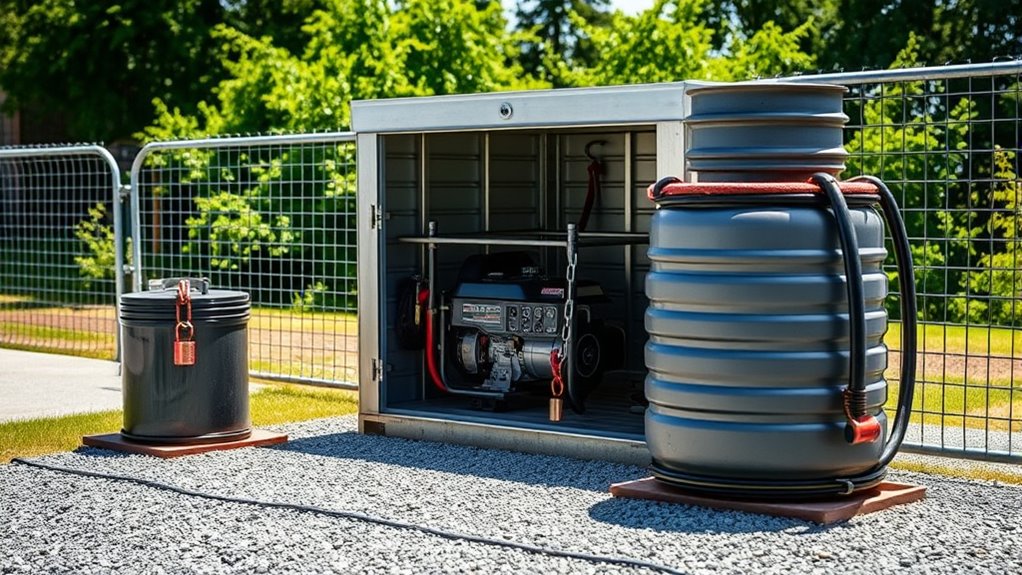
Secure fuel storage is essential to prevent opportunistic theft and minimize safety hazards. Use approved, color-coded containers designed for specific fuel types—red for gasoline, yellow for diesel, and appropriate tanks for propane—to avoid mix-ups. Make certain containers have safety features like flame arrestors, vents, and leak-proof seals to reduce fire risks. Store fuel in cool, dry, well-ventilated areas away from living spaces and direct sunlight, such as detached sheds or garages. Use secondary containment systems to prevent spills and comply with local safety regulations. Lock fuel containers in secure enclosures or cabinets, and consider adding security cameras or alarms for added protection. Clearly label containers with dates and types, and keep inventory logs to detect theft early. Regular inspections and proper handling enhance overall safety and security. Additionally, ensuring proper maintenance and cleaning of fuel containers can prevent leaks and deterioration over time. Maintaining fuel quality through proper storage practices further reduces the risk of accidents and extends the lifespan of your fuel supplies. Incorporating security measures such as motion-activated lighting can also deter potential thieves and improve overall site safety.
Develop and Practice Theft Response and Recovery Plans

To effectively respond to generator theft, you need clear procedures that outline immediate actions and coordination with law enforcement. Regular drills help guarantee everyone knows their roles and can act quickly if theft occurs. By practicing these plans consistently, you’ll be better prepared to recover your equipment swiftly and minimize damage. Establishing reliable safety protocols ensures everyone understands how to handle theft incidents properly. Additionally, understanding the importance of diversification strategies can help you protect your assets more effectively in various scenarios. Incorporating security system costs and evaluating different monitoring options can also enhance your preparedness.
Establish Clear Procedures
Establishing clear procedures for theft response and recovery guarantees everyone knows their role when an incident occurs. First, you should define steps to report theft immediately to law enforcement, sharing serial numbers and identifiers. Second, set protocols to alert your security team and stakeholders quickly, ensuring everyone stays informed. Third, develop a plan to monitor online marketplaces and social media for stolen generators, aiding in recovery efforts. Assign specific roles to staff, such as contacting recovery companies or coordinating with police. Formalize communication guidelines to keep updates organized and accurate, preventing confusion during critical moments. Additionally, understanding the individual responses of your team and stakeholders can help tailor your response plan to be more effective. Incorporating technology solutions, such as surveillance cameras and GPS tracking, can significantly enhance your ability to locate and recover stolen equipment. Regular training exercises and clear communication channels can further prepare your team for actual incidents, improving overall response efficiency. Incorporating technology solutions, such as surveillance cameras and GPS tracking, can significantly enhance your ability to locate and recover stolen equipment. Clear, practiced procedures help you act swiftly and efficiently, increasing the chances of recovering your generator and minimizing damage.
Conduct Regular Drills
How can you guarantee your theft response and recovery plans are effective? The key is to develop and regularly practice detailed drills. Create step-by-step protocols for different theft scenarios, including attempted theft, successful theft, and suspicious activity. Make certain your team knows how to notify law enforcement and security personnel quickly. Conduct simulation exercises often to improve reaction times and coordination. Incorporate technology, like GPS tracking and alarm systems, into these drills to test their functionality under stress. Train staff on identifying stolen generators and documenting evidence for recovery efforts. After each drill, review performance, identify weaknesses, and update your plans accordingly. Regular practice keeps everyone prepared, sharpens response times, and strengthens your overall security against generator theft.
Utilize Surveillance and Site Security Measures

Implementing effective surveillance and site security measures is essential for protecting your generator from theft and vandalism. You can substantially improve security by:
Effective security guards and surveillance deter theft and vandalism.
- Installing high-definition security cameras with night vision, positioned to cover the generator and entry points, and integrating them with alarms for real-time alerts.
- Using motion-activated lighting and alarms sensitive to vibrations or unauthorized movement to deter intruders and send instant notifications to your phone.
- Enhancing visibility with well-placed outdoor lighting and maintaining clear sightlines, combined with physical barriers like secure fencing and heavy-duty locks, to restrict access and reduce concealment spots.
These layered measures create a robust security setup, making it harder for thieves to target your generator unnoticed.
Collaborate With Law Enforcement and Security Agencies
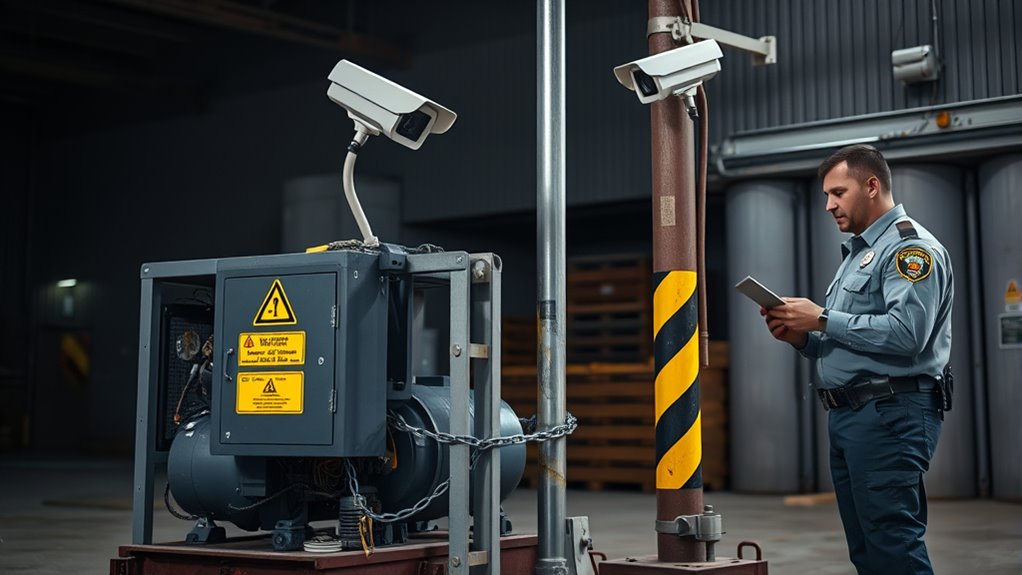
Partnering with local law enforcement and security agencies is a crucial step in safeguarding your generator. You should collaborate with police to access crime stats and theft pattern insights specific to your area. Keep open lines of communication with key contacts for quick response if theft occurs. Reporting suspicious activity or theft incidents immediately helps law enforcement respond swiftly and increases recovery chances. Participating in community crime prevention programs enhances vigilance. Additionally, seek law enforcement advice on best security practices and legal considerations. Document your generator’s serial number, register it in relevant databases, and provide detailed descriptions to aid recovery efforts. Working with neighborhood watch groups and security providers further strengthens your defenses. Coordinated efforts with authorities create a thorough shield against theft.
Frequently Asked Questions
What Are the Best Materials for Building a Theft-Resistant Generator Enclosure?
You should choose galvanized steel for your generator enclosure because it’s durable, corrosion- and fire-resistant, and offers strong theft protection when locked. Aluminum is a lightweight, cost-effective alternative with excellent long-term performance. Avoid stainless steel due to rust risk. Incorporate tamper-resistant bolts, concealed hinges, and reinforced panels to deter intruders. Using weatherproof coatings and sealed joints will protect against environmental damage, ensuring your generator stays secure and functional over time.
How Often Should Security Systems and Tracking Devices Be Tested and Maintained?
You should test your security system monthly to verify it’s working properly and respond to any issues promptly. Tracking devices need to be checked quarterly to confirm they transmit accurate location data. Regular maintenance, like battery replacements every 6-12 months and monthly cleaning of sensors, keeps everything functioning smoothly. High-risk areas or harsh environments might require more frequent checks, so stay vigilant to protect your generator effectively.
What Training Should Staff Receive to Effectively Respond to Generator Theft Incidents?
You should train staff on incident response roles, emphasizing quick detection, reporting, and escalation procedures. Conduct practical theft simulations to reinforce responses, and teach chain of custody and evidence preservation. Educate on communication protocols with law enforcement and internal teams. Also, train staff to recognize security weaknesses and suspicious activity, ensuring they know how to monitor access points and respond effectively. Regular updates based on past incidents improve preparedness and security measures.
Are There Legal Restrictions or Permits Needed for Installing Certain Security Measures?
You need to jump through legal hoops to install certain security measures around your generator. Permits are often required for fences, cages, or enclosures, and alarm or camera systems must follow local privacy and noise laws. You also need approval from landlords if you’re renting. Ignoring these rules could turn your security setup into a legal nightmare, so always check your local regulations before installing any security device.
How Can I Verify the Authenticity of a GPS or RF Tracking Device Before Installation?
To verify your GPS or RF tracking device’s authenticity, start by checking the serial number and model against the manufacturer’s official website or authorized distributors. Examine the packaging for branding and holograms, and guarantee the device matches the technical specifications. Use the manufacturer’s app to activate and register it. Test the device outdoors with official software, verify firmware updates, and look for certifications like CE or FCC to confirm it’s genuine.
Conclusion
By taking these steps, you create a fortress around your generator — from sturdy fences to sharp-eyed cameras. Picture a well-lit yard, where shadows hide nothing, and alarms sound the moment someone tries to breach your defenses. With clear procedures and strong partnerships with law enforcement, you stand vigilant. Your generator, protected and secure, becomes a silent guardian, ready to power through any threat, ensuring peace of mind even in the darkest nights.

